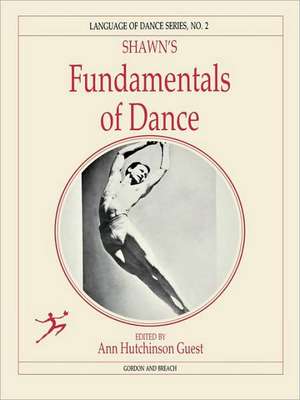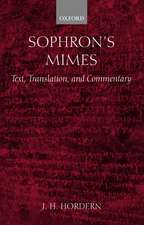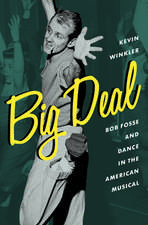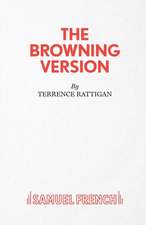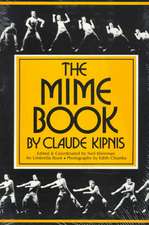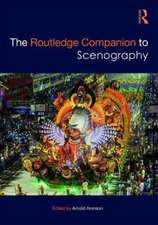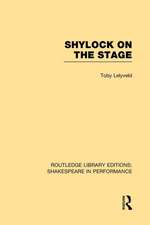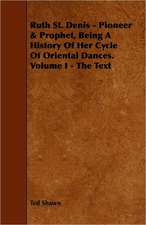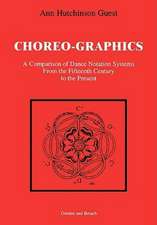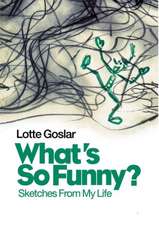Shawn's Fundamentals of Dance: Language of Dance
Editat de Anne Hutchinson Guesten Limba Engleză Paperback – 1988
| Toate formatele și edițiile | Preț | Express |
|---|---|---|
| Paperback (1) | 580.14 lei 6-8 săpt. | |
| Taylor & Francis – 1988 | 580.14 lei 6-8 săpt. | |
| Hardback (1) | 1014.74 lei 6-8 săpt. | |
| Taylor & Francis – 14 sep 2017 | 1014.74 lei 6-8 săpt. |
Preț: 580.14 lei
Preț vechi: 682.51 lei
-15% Nou
Puncte Express: 870
Preț estimativ în valută:
111.02€ • 115.48$ • 91.66£
111.02€ • 115.48$ • 91.66£
Carte tipărită la comandă
Livrare economică 14-28 aprilie
Preluare comenzi: 021 569.72.76
Specificații
ISBN-13: 9782881242199
ISBN-10: 2881242197
Pagini: 134
Ilustrații: 1
Dimensiuni: 210 x 280 x 7 mm
Greutate: 0.32 kg
Ediția:1
Editura: Taylor & Francis
Colecția Routledge
Seria Language of Dance
Locul publicării:Oxford, United Kingdom
ISBN-10: 2881242197
Pagini: 134
Ilustrații: 1
Dimensiuni: 210 x 280 x 7 mm
Greutate: 0.32 kg
Ediția:1
Editura: Taylor & Francis
Colecția Routledge
Seria Language of Dance
Locul publicării:Oxford, United Kingdom
Cuprins
Study and Performance Notes; Chapter I General Stretching Set; Chapter II Figure Eight Swings; Chapter III Tension – Relaxation – Set One; Chapter IV Tension and Relaxation – Set Two; Chapter V Floor Set; chapter VI Three Jumps; chapter VII Walking, Running, Leaping; chapter VIII Long Adagio (Balance Exercise); Chapter IX Single Arm Swing and Development; Chapter X Three Delsarte Falls, Rising and Falling; Chapter XI Series of Successions;
Notă biografică
Edited by Guest, Anne Hutchinson
Descriere
Descriere de la o altă ediție sau format:
How do conscious experience, subjectivity, and free will arise from the brain and the body? Even in the late 20th century, consciousness was considered to be beyond the reach of science. Now, understanding the neural mechanisms underlying consciousness is recognized as a key objective for 21st century science. The cognitive neuroscience of consciousness is a fundamentally multidisciplinary enterprise, involving powerful new combinations of functional brain imaging, computational modelling, theoretical innovation, and basic neurobiology. Its progress will be marked by new insights not only into the complex brain mechanisms underlying consciousness, but also by novel clinical approaches to a wide range of neurological and psychiatric disorders.These innovations are well represented by the contents of the present volume. A target article by Victor Lamme puts forward the contentious position that neural evidence should trump evidence from behaviour and introspection, in any theory of consciousness. This article and its several commentaries advance one of the fundamental debates in consciousness science, namely whether there exists non-reportable phenomenal consciousness, perhaps dependent on local rather than global neural processes. Other articles explore the wider terrain of the new science of consciousness. For example, Maniscalco and colleagues use theta-burst transcranial magnetic stimulation to selectively impair metacognitive awareness; Massimini and coworkers examine changes in functional connectivity during anesthesi, and Vanhaudenhuyse et al describe innovations in detecting residual awareness following traumatic brain injury.Together, then contents of this volume exemplify the `grand challenge of consciousness' in combining transformative questions about the human condition with a tractable programme of experimental and theoretical research.
How do conscious experience, subjectivity, and free will arise from the brain and the body? Even in the late 20th century, consciousness was considered to be beyond the reach of science. Now, understanding the neural mechanisms underlying consciousness is recognized as a key objective for 21st century science. The cognitive neuroscience of consciousness is a fundamentally multidisciplinary enterprise, involving powerful new combinations of functional brain imaging, computational modelling, theoretical innovation, and basic neurobiology. Its progress will be marked by new insights not only into the complex brain mechanisms underlying consciousness, but also by novel clinical approaches to a wide range of neurological and psychiatric disorders.These innovations are well represented by the contents of the present volume. A target article by Victor Lamme puts forward the contentious position that neural evidence should trump evidence from behaviour and introspection, in any theory of consciousness. This article and its several commentaries advance one of the fundamental debates in consciousness science, namely whether there exists non-reportable phenomenal consciousness, perhaps dependent on local rather than global neural processes. Other articles explore the wider terrain of the new science of consciousness. For example, Maniscalco and colleagues use theta-burst transcranial magnetic stimulation to selectively impair metacognitive awareness; Massimini and coworkers examine changes in functional connectivity during anesthesi, and Vanhaudenhuyse et al describe innovations in detecting residual awareness following traumatic brain injury.Together, then contents of this volume exemplify the `grand challenge of consciousness' in combining transformative questions about the human condition with a tractable programme of experimental and theoretical research.
